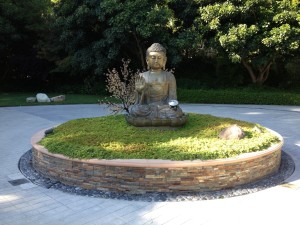Thoughts About The Statue Of Buddha
I have a huge statue of Buddha (about five-feet tall and 800 pounds) in my front garden. It’s unique, inspiring, and pleasing, and even a glance reassures me that everything’s going to be okay in a larger sense.
The feeling reminds me of when my son Blake was a little boy sharing his fears. We’d discuss, them, and I’d tell him it would be okay, and he would trust me and let go of the issue. Seeing the Buddha triggers that kind of response for me, as if someone I trust is telling me, “It’s going to be okay.” What does okay mean?
There are three things that always result in upsets. They are attachments to:
1. Unfulfilled expectations
2. Thwarted intentions
3. Incomplete communications
Whenever I’m agitated, it’s because I can’t get something I’m attached to wanting (in other words, I have an unfulfilled expectation or thwarted intention) or because my words or deeds are ignored (an incomplete communication).
Hence, Buddha’s huge “aha” realization – that all human suffering comes from our attachment to people, things, and/or desires. The default belief system of our machinery (the term I use for the workings of our mind when we’re on automatic pilot) includes the belief that we must have it– whatever it is we’re attached to – in order to survive.

Buddha statue
Attachment is a point of view in our machinery’s programming. It’s as if the machinery itself has an innate gravitational pull to our attachments, which are embedded in our minds as if what we’re telling ourselves is true when it’s only a story that we told ourselves and that we refuse to see as a story, believing that it’s both real and the truth.
About 2500 years ago, the Buddha let us know that we are each a self-contained, self-generating universe, connected to all things and people. To remember this and fight the tendency toward attachment from my machinery, I practice mindfulness: I focus on the present, let go of the voice in my head that tells me interpretations and judgments from my past, talk to myself with intention, and remind myself that life works perfectly and I don’t have to do anything to it.
When people ask me, “How are you?,” I tell them, “I am the perfect me.” This is very similar to my late friend Dennis Rossoff, a preeminent Beverly Hills furrier, who once looked at my dog and said, “You know, Steven, that dog’s coat is a perfect fit.” I remind myself that I am perfect as we all are, in the same way that every animal has a coat with a perfect fit.
NO ATTACHMENT NECESSARY!
One of my mantras is “Life works perfectly, you don’t have to do a thing to it” and it means that whatever is happening that life has brought me is the Universe’s perfect, logical consequence for the string of events and experiences that have led up to this moment.
I remind myself that yes, it is perfect, but often perfect does not fit my picture – which is why it’s important to remember that at this moment I also have the ability to make mindful choices that can change my experience.
When our attachment to our pictures is so strong that it makes it seem as if we’re not going to get what we believe we need, our machinery has a tendency to go out of whack, as if something is wrong. This gets us activated, which creates all sorts of distorted feelings that get in the way of acting mindfully and of recognizing the Universe’s perfection.
Seeing the image of the Buddha reassures me that everything will be okay. It reminds me that the Universe is perfect, and that if I’m upset because it doesn’t seem perfect, it’s because I’m letting my machinery run me. If I’m mindful, I will see the perfection of the Universe, and I will know, with my inner knowing, that everything is, indeed, okay.
- 4 Jul, 2013
- Posted by Steve Fogel
- 0 Comments



COMMENTS